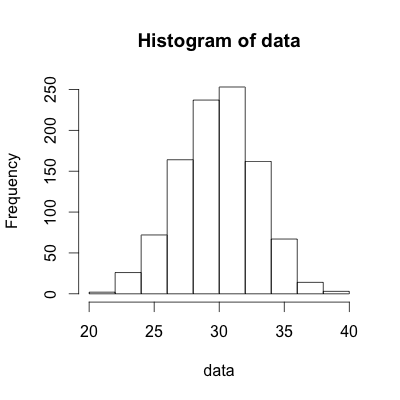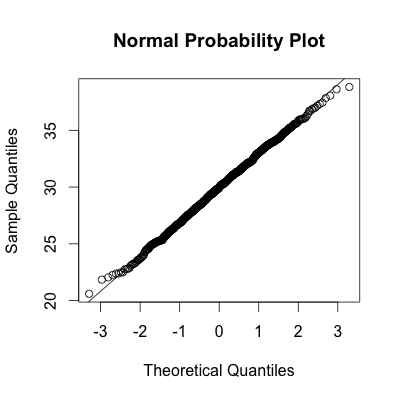R: Normal Distribution
If X~N(μ, σ), use the pnorm(x, μ, σ) function to calculate P(X < x).
> pnorm(81, 85, 5)
[1] 0.2118554
> # Calculate z
> z = (81 - 85)/5
> z
[1] -0.8
>
> # define standard normal
> pnorm(z, 0, 1)
[1] 0.2118554
>
> # if the mean and sd not provided,
> # R assumes mean = 0, sd = 1
> pnorm(z)
[1] 0.2118554
II. Calculating P(X > x)
If X~N(μ, σ), use the pnorm(x, μ, σ, lower.tail = FALSE) function to calculate P(X > x). A second method would be to subtract pnorm(x, μ, σ) from 1.
Example 1:
# Method 1 - Use "lower.tail = FALSE"
> pnorm(81, 85, 5, lower.tail = FALSE)
[1] 0.7881446
# Method 2 - Subtract pnorm(x, n, p) from 1
> 1 - pnorm(81, 85, 5)
[1] 0.7881446
> qnorm(0.75, 30, 3)
[1] 32.02347
Example 2: Jetblaster is a popular game app. Scores on the game are normally distributed with a mean of 1,114 and a stanard deviation of 321. Jack wishes to qualify for the national tournament. Only those who have a score in the top 10% qualify. What is the minimum score Jack needs to qualify for the national tournament? (Hint: The 90th percentile is the cutoff to score in the top 10 percent.)
> qnorm(0.9, 1114, 321)
[1] 1525.378
In statistics, one often finds the need to simulate random scenarios that are normally distributed. To do this, we need to use the rnorm(n, μ, σ) function, where n represents the number of random observations you wish to observe.
Example 1:
> rnorm(8, 1114, 321)
[1] 976.8647 1294.5687 512.8734 931.0832
[5] 1286.8615 1076.7246 1020.6694 1414.6181
Conclusion: The above code simulated 8 Jetblaster game scores. As one can interpret from the results, the first score was 976.8647, and the second score was 1294.5687.
Often one must try to assess if data is actually normally distributed. There are a few methods available to do this. One very popular method is to construct a normal probability plot.
Example 1:
# Randomly sample 1000 observations from N(30, 3)
data = rnorm(1000, 30, 3)
# Construct histogram
hist(data)
# Construct Normal Probability Plot
qqnorm(data, main = "Normal Probability Plot")
# Add diagonal line to help with normality assessment
qqline(data)
 |
 |
Conclusion: As one would expect given that the data was drawn from the normal distribution, the histogram clearly looks to be normally distributed. Upon inspection of the Normal Probability Plot, one can see that the points line up with the line. When the points line up well with the horizontal line, one can assume the data is normally distributed, as is the case shown above.

This work is licensed under a Creative Commons Attribution-NonCommercial-ShareAlike 4.0 International License.
